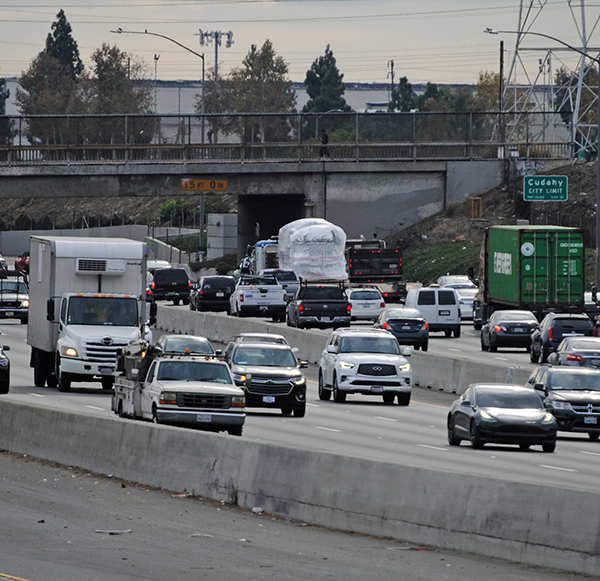By Alfredo Santana
Contributing Writer
LOS ANGELES — Four transportation improvement projects to alleviate greenhouse fuel emissions and ease the movement of people and goods along the Long Beach (710) Freeway were announced at a community committee hearing Sept. 22 following their approval by the Metropolitan Transportation Authority’s Board of Directors earlier in the day.
The projects the MTA committed to back with letters of support and grant applications for state and federal funds are the Humpreys Avenue Bike and Pedestrian Crossing over the freeway in East Los Angeles, a Huntington Park safe routes for students and senior citizens project, the 710 Integrated Corridor Management Project and the Southeast Los Angeles Transit Improvement Program.
All are part of a plan to bring innovative solutions to transportation and pollution woes plaguing working-class communities along the freeway’s 19-mile corridor from Long Beach to East Los Angeles.
None of the projects would siphon funds from the nearly $1 billion the MTA has saved for the I-710 Investment Plan being assembled by a community task force with input and advice from a community leadership committee and other working groups.
At the monthly community leadership committee meeting Sept. 22, MTA interim executive officer Michael Cano said that pending environmental and logistic studies, the next steps are to coordinate efforts with local jurisdictions and the state’s Department of Transportation to develop and implement the chosen programs.
On behalf of County Supervisor Janice Hahn, Cano congratulated the community leadership committee and task force members for offering feedback on the selected plans, selected out of nearly 30 proposals.
By picking the four projects, Cano said the MTA board concluded that they closely aligned with the goals set forth by the working groups in the investment plan that highlight equity and aim to undo past injustices.
“We do appreciate the questions and information we need to make these improvements happen in the coming months,” Cano told the group.
The Integrated Corridor Management Project would consist of an integrated alert system available through an app to allow drivers on the freeway to find escape routes following a crash that blocks lanes or on and off ramps.
Ed Alegre, project manager and chair of the MTA’s Mobility Department, said he has engaged with multiple agencies that control street traffic within the corridor.
The MTA estimates that project would cost $30.2 million, and would be eligible for grants from the state’s Trade Corridor Enhancement Program if the agency meets the Nov. 18 deadline to apply for allocations.
If the state resources are approved, the MTA would contribute $7.2 million in matching funds.
“This project will help manage stale traffic to come off so it can go back up rapidly and out of the freeway,” Alegre said.
The app would operate with Google Transit or with other web options that help map the best alternatives to get to where the drivers are going, he said.
“We have been talking with different cities, Caltrans and [the MTA] to make sure what their needs are and make sure they are covered” in the digital system, Alegre said.
For cyclists and pedestrians, Alegre said that future tech innovations would allow them to come up with their own routes and better plan their transit movements.
An immediate advantage is that the app would not add harm to the region’s roads because it does not use a physical space in the corridor, and will rapidly contribute to decongestion when needed, Alegre said.
He also highlighted the app would increase safety for all users, support efforts to mitigate carbon dioxide emissions and optimize traffic flow with little or zero disruptions to the freeway since it is a digital system.
Currently, about 100 intersections have been added to the system, which will update changes with environmental sensors, data sharing from local agencies, information from travelers and satellite navigation feeds from Google Waze.
In the event of a crash, the app would detect the incident and provide options for motorists stuck in traffic.
Committee member Teisha Davis said that in Compton many street intersections near light rail stations and bus hubs are not lit up and those that work do not have bike or pedestrian signs and lack audible indicators to raise safety for pedestrians.
Davis asked Alegre and Cano to address those signal voids and incorporate them into the Integrated Corridor Management Project for a more comprehensive system.
Her colleague Phyllis Ollison inquired what the time frame would be for the system to gather accident data and offer escape options, and said both Caltrans and the MTA should consider installing more traffic alert boards along the freeway, “because the existing ones are few and far between.”
“If an incident is noted, [the project] will initiate Plan A,” Alegre said. “They’ll see it from the sensors or curves. The system will make all lights go green to release the traffic backup. And we’ll be using audible signatures to give more info to flee a disaster. Also, Google apps will give more info to the driver.”
Other announcements included the presentation of Luis Mesa from Bell as a new committee member, the MTA board’s approval to rebrand the plan as the Long Beach-East LA Corridor Mobility Investment Plan and the new definition for a prosperity goal.
The prosperity goal should “strengthen L.A. County’s economic competitiveness and increase access to quality jobs, workforce development, and economic opportunities for all communities, with a focus on strengthening the 710 corridor communities, which have been and continue to be harmed by economic development.”












